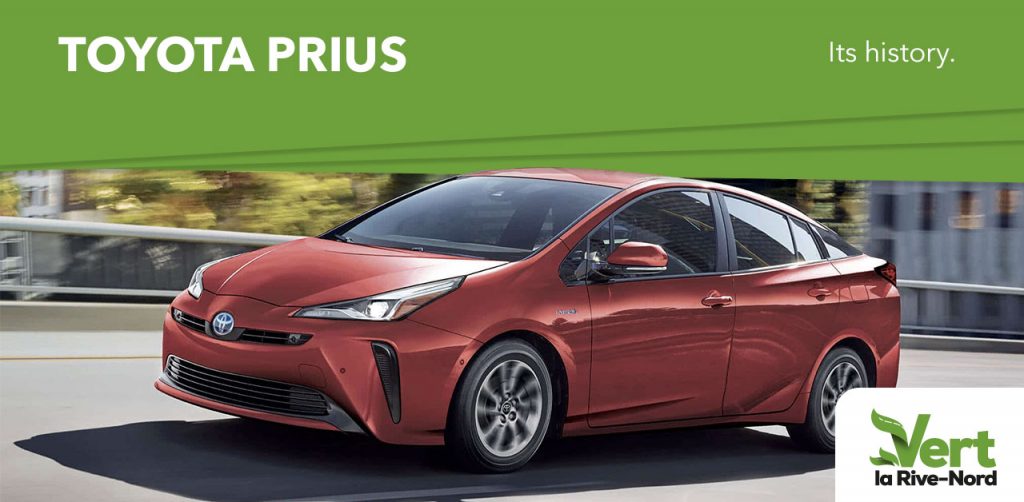For the last few years, hybrid cars have become more and more popular, especially the rechargeable hybrid vehicle models. They marry the current trends in terms of the environment and the diminution of greenhouse gases (GES). They are made with gas and electric engines. They are more and more performant and allow you substantial savings on gas consumption.
Vert La Rive-Nord, these dealerships who specialize in the more ecological models at Toyota Saint-Jérôme and Toyota Saint-Eustache on the North Shore of Montreal, initiate you in this blog to the legendary Toyota Prius, with everything it includes on the environmental and eco energetic plans.
The Legendary Prius, as Hybrid as Ever!
The Toyota Prius and I learned that it has been on the market since 1997. It was first commercialized in Japan before being released in the rest of the world in 2000. It is one of the cleanest vehicles sold in North America, based on its greenhouse gas emissions.
This sub-compact hybrid sedan is now the biggest seller in the world. In 2019, nearly 4.4 million units had been sold across the planet.
Right from the start in 1997, Toyota was visionary for choosing to put on the market a hybrid vehicle bearing the name Prius, which translates to “first”, “original” and “superior” in Latin. Twenty-two years later, the Japanese builder is top of its class with the Prius.
It’s important to know that back then, the Prius became the first gas/electric car to be mass-produced in the world. Successively winning the awards of car of the year in Japan and car of the year in the research group in 1997 and 1998, the number of units on the market neared 37,500 in 2000.
Two models were put on the market between 1997 and 2003. The style of the NHW10 Prius, only available in Japan, has been produced by Californian designers recruited by Toyota. The NHW11 Prius became the first hybridized model sold outside of Japan, which includes the United States and Canada. This Prius created an instant craze among the population, based on its higher speed and its long-distance capabilities. It’s actually this model that enabled Toyota to reach its threshold of profitability and become the pioneer for hybrid vehicles in the world.
With the second generation, which extended from 2003 to 2009, we witnessed the appearance of the NHW20 model, which is a complete redesign of the precedent model. From there on, the Prius offered more leg and storage room. The second generation Prius is also much more ecological and it is longer than the NHW10 model. In 2004, the Prius NHW20 was classified as a SULEV vehicle, which stands for Super Ultra Low Emissions Vehicle. In 2007, the Prius took over the Chinese market and Toyota registered a record number of units sold, which was over 1.1 million.
With the third generation, which went from 2009 to 2015, Toyota pursued its innovations by introducing 3 optional driving modes: the EV mode for low-speed functioning (electric only), the Eco mode for optimal energy efficiency, and the Power mode for added performance. The body comes in a more aerodynamic format, a new platform allows to increase the length, and the materials used are lighter. Finally, a fender arch gives the vehicle more stability at higher speeds.
The present generation, which extends from 2015 to today, is marked by improvements and innovative features. Today, the Prius uses the modular Toyota TNGA platform that offers increased rigidity. Versions Prius C, Prius V and Prius Prime are born during this generation.
The Prius C is a sub-compact hybrid vehicle which offers room for 5 occupants. It also has a youthful look, possesses innovative technologies and a set of advanced security systems. It consumes as little as 4.5 L/100 km in the city and 5.5 L/100 km on the highway.
The Prius V is an eco-energetic multi-segment hybrid that offers you an interior axed on family with loads of leg and storage space. Its consumption is of 5.5 L/100 km in the city and 6.0 L/100 km on the highway.
Finally, the Prius Prime, a rechargeable hybrid, has a progressive style, possesses numerous state-of-the-art technologies which will bring you very, very far… It consumes as little as 4.3 L/100 km in the city and 4.4 L/100 km on the highway.
In 2019, a study realized by iSee Cars has ranked the Prius second in vehicles kept the longest by American drivers. This data also coincide with the testimonies given by Prius drivers in Quebec.
On a final note, Toyota constructor has brilliantly rose to the hybridization challenge and has joined with confidence in the development of highly eco-energetic new vehicles. The combination of a gas engine with an electric engine constitutes a very interesting tendency in the automobile industry.
From here on, the Prius Hybrid is useful both in the city and on the highway. The longevity of the lithium battery (ion lithium) allows to cover long distances. Furthermore, the power and performance are a constant in today’s hybrid vehicles at Toyota. Without a doubt, the 2019 Toyota Prius is a vehicle with a great future. After 22 years on the market, it is still prized by numerous international associations and constitutes the car of today and tomorrow.
Vert La Rive-Nord: Two Dealerships, One Reality!
By combining their qualities and their strengths, Toyota St-Jérôme and Toyota St-Eustache have designed an innovative concept and have become the pioneers of the ecological trend on the roads. The Prius, who remains a leader in the world of hybrid vehicles, is a legend born under a good star and shines with all of its glory. With its new versions, it remains the most affordable hybrid vehicle in Canada. Come discover the 2020 Prius today!

